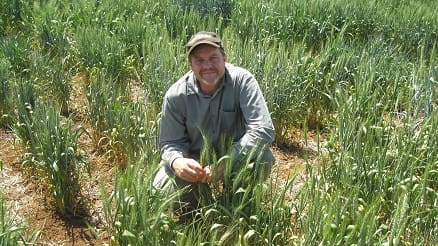MANAGING crown rot has become virtually second nature to growers in northern New South Wales and Queensland over the past 10 years.
It’s a risk most growers now routinely factor into key management decisions on crop and variety selection, sowing time and planting configuration in a bid to avoid potential yield losses which can be more than 50 per cent if not managed.
The crown rot fungi are stubble borne fungal pathogens that can affect all winter cereals by restricting the flow of water and nutrients to developing heads when moisture or heat stress occurs during the critical grain filling stage. This can result in pinched grain or heads with no grain, otherwise known as ‘whiteheads’.
Dry conditions in 2018 heralded a significantly smaller wheat and barley plant with generally reduced biomass and yield production. However, experts are still expecting most growers to remain on crown rot alert in recognition that vigilance is the key to management over the longer term.
NSW Department of Primary Industries (DPI) senior plant pathologist Dr Steven Simpfendorfer said crown rot inoculum levels were a function of biomass/number of tillers produced, both of which tended to be reduced in a dry year, and the percentage of plants infected by the pathogen.
Hence, inoculum levels, while not increasing as much as in a wetter year, are still maintained in lower yielding cereal crops in drier seasons.
“A potentially bigger issue in a dry year is reduced stubble decomposition due to lack of moisture which restricts displacement of crown rot inoculum, especially in standing cereal stubble, even if a break crop was grown in 2018,” Dr Simpfendorfer said.
“Effective crown rot management is a long term commitment. It hinges on using a combination of tactics including break crops to reduce inoculum levels in paddocks, inter-row sowing to limit infection levels, fallow management, cereal crop and variety choice, sowing time and addressing other sub-soil or soil-borne constraints such as sodicity and root lesion nematodes.
“So, it’s important that growers remain vigilant and opt for PREDICTA B testing ahead of this year’s winter crop plant so they can make informed decisions about crop and variety selections and tweak their longer term disease management programs if necessary.”
PREDICTA B is a DNA-based soil test that has been successfully used by growers and advisers for years to assess crown rot inoculum levels and guide crop/variety and paddock selection, long term disease management and the identification of other soil-borne diseases or root lesion nematode issues.
The testing is continually evolving to support growers across different regions. A test for inoculum levels related to Ascochyta blight of chickpeas and two tests for beneficial Arbuscular Mycorrhizal Fungi (AMF), which when at low numbers cause long-fallow disorder, were added to the northern region options in 2018.
It’s an important research investment for the Grains Research and Development Corporation (GRDC) and is commercially available to growers through the South Australian Research and Development Institute (SARDI).
Testing soil samples with added stubble/plant residue before planting is the most effective way to assess the risk of crown rot within individual paddocks.
For results to be accurate, PREDICTA B requires a dedicated sampling strategy and is not a simple add on to a soil test.
Sampling recommendations for northern-based growers are:
- Collect two cores of 1 centimetre diameter and 15 centimetres deep from each of 15 different locations within the target paddock or production zone.
- Samples may be taken to a depth of 30cm if growers are concerned about Pratylenchus thornei
- If using a larger diameter core or coring to 30 cm, take fewer cores per location.
- Take soil cores from along/in the rows of the previous cereal crop if still visible and retain any stubble collected by the core. Most soil-borne pathogens are concentrated under the rows of the last cereal crop.
- If the rows cannot be seen, take the cores at random.
- Add two pieces of cereal stubble (or grass weed), if present, to the sample bag at each of the 15 sampling locations to improve the detection of crown rot.
- Each piece should be a single dominant tiller from the base of different plants and include the crown to the first node. Discard material from above the first node.
- Maximum sample weight should not exceed 500 grams.
Source: GRDC
Crown Analytical Services (CAS) is the service co-ordinator for the northern region PREDICTA B test and can provide northern growers and advisers with bags, soil corers, protocols and procedures for sampling as well as an interpretation of results once tests are completed.
PREDICTA B kits can be obtained from CAS by contacting 0437 996 678 or email [email protected] or for more information on the PREDICTA B tests visit the SARDI website www.pir.sa.gov.au.
Dr Simpfendorfer will be presenting a crown rot update at the GRDC Grain Research Updates in Goondiwindi on March 5 and 6. The Updates will be held at the Goondiwindi Community Cultural Centre.




HAVE YOUR SAY